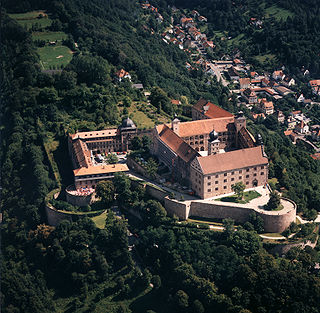
Franconia is a region of Germany, characterised by its culture and Franconian dialect.

Plassenburg is a castle in the city of Kulmbach in Bavaria. It is one of the most impressive castles in Germany and a symbol of the city. It was first mentioned in 1135. The Plassenberg family were ministerial of the counts of Andechs and used as their seat the Plassenburg. The House of Guttenberg, a prominent Franconian noble family, traces its origins back to 1149 with a Gundeloh v. Blassenberg (Plassenberg). The name Guttenberg is derived from Guttenberg and was adopted by a Heinrich von Blassenberg around 1310. From 1340, the Hohenzollerns governed from Plassenburg castle their territories in Franconia till 1604. The Plassenburg was fortress and residence for the Hohenzollerns.

Bad Staffelstein is a small town in the Bavarian Administrative Region of Upper Franconia in Germany. It has around 10,000 inhabitants.

Lichtenfels is a town in the Upper Franconian region of Bavaria, Germany, the administrative seat of Lichtenfels district. It is chiefly known as the German "Basket City".

Organisation Consul (O.C.) was an ultra-nationalist and anti-Semitic terrorist organization that operated in the Weimar Republic from 1920 to 1922. It was formed by members of the disbanded Freikorps group Marine Brigade Ehrhardt and was responsible for political assassinations that had the ultimate goal of destroying the Republic and replacing it with a right-wing dictatorship. The group was banned by the German government in 1922.

DukeMaximilian Joseph of Bavaria, known informally as Max in Bayern, was a member of a junior branch of the royal House of Wittelsbach who were Kings of Bavaria, and a promoter of Bavarian folk-music. He is most famous today as the father of Empress Elisabeth of Austria ("Sisi") and great-grandfather of King Leopold III of Belgium.

Prince Alfons of Bavaria was a member of the Bavarian Royal House of Wittelsbach and a General of Cavalry.

Prince Arnulf of Bavaria was a member of the Bavarian Royal House of Wittelsbach and a General of Infantry.
Gerhard Stapelfeldt is a German sociologist. He was a university teacher at University of Hamburg until December 2010.
Tragelhöchstädt is a village in the municipality of Uehlfeld in the district of Neustadt (Aisch)-Bad Windsheim in Bavaria in Germany.

The Lichtenfels Forest is a forest northwest of the town of Lichtenfels in Upper Franconia in northern Bavaria, Germany.

The Rezatkreis, between 1806 and 1837, was one of the 15 districts of the Kingdom of Bavaria. Its name meant in German the “District of the Rezat” because the Fränkische Rezat River ran through it. It was the predecessor of the Regierungsbezirks Mittelfranken. Its center was Anspach.

The Free State of Coburg emerged from the Duchy of Saxe-Coburg and Gotha at the end of the First World War. It existed from November 1918 until its union with the Free State of Bavaria on 1 July 1920.

Höglwörth Abbey is a former monastery of the Augustinian Canons in Höglwörth, near Anger in Bavaria, in the Archdiocese of Munich and Freising.
Steinbach is a river of Bavaria, Germany.

Creidlitz is a southern suburb of 1705 inhabitants of the city of Coburg in the county of Upper Franconia in the state of Bavaria in Germany.

Weinzierlein is a village in the town of Zirndorf in the Central Franconian district of Fürth in Bavaria, Germany.
The Institute of Bavarian History at the Ludwig Maximilian University (Ludwig-Maximilians-Universität) in Munich is a centre of research and teaching of Bavarian history in a European context. It is located in the building complex of the Bavarian State Archives and in the immediate vicinity of the Bavarian State Library.

Häusling is a village in the city of Erlangen. Its resident population was 203 in 2020.

Hütting is a parish village, part of the market municipality of Rennertshofen, in the district of Neuburg-Schrobenhausen, in the region of Upper Bavaria, Germany.




















